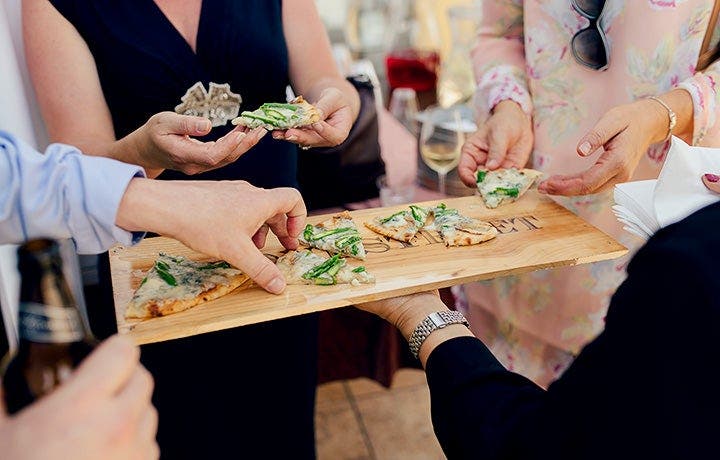How to Create a Wedding Menu


While the flexibility of WW makes it easy to have a wedding menu that works with your plan, there are some strategies that make it even easier. (You can use some of these tips to navigate the menu at someone else’s wedding, too.)
Tips for a Healthier Wedding Menu
Serve apps
“If you don’t eat for a long time, then drink alcohol during cocktail hour, you’re going to naturally go overboard with food when dinner is served,” says Dana Hunnes, PhD, senior dietitian at Ronald Reagan UCLA Medical Center and adjunct assistant professor at the UCLA Fielding School of Public Health in Los Angeles.
That’s why it’s so important to serve low-calorie, high-fiber appetizers while you’re milling around with guests after the ceremony. “Skewers are a great idea—whether it’s chicken or tofu satay, fruit, or tomato and cucumber with some hummus wedged between,” says Hunnes. “Those are way healthier than a mini-quiche or the typical fried appetizers.”
Have fun alcohol-free drinks
“Skinny cocktails or wine coolers are fine, but also have some non-alcoholic options,” says Hunnes. “Fruit-infused water in lovely containers gives you and your guests a unique beverage to have between boozier drinks.”
Go with a plated dinner instead of a buffet
Portion control can go out the window when you’re walking down a buffet line. “The novelty of all the different food choices compels you to take more,” says Hunnes. That’s why plated dinners are a good idea. “When you’re served a meal, the portion tends to be smaller than what you’d put on your plate yourself,” she explains.
Then, take the time to eat it! Too many brides get swept up in the event and never taste the food. But taking a moment to eat your meal can keep you energized throughout the evening, and will make a cake-and-drinks-only evening less likely.
Make the salad special
“A simple side salad isn’t very appealing, so ask your caterer to mix in some different greens—like a softer butter lettuce, crunchy escarole, and some pretty purple lettuces,” says Rachel Clark, RD, CSSD, sports dietitian and continuing lecturer in the Department of Nutrition Science at Purdue University in West Lafayette, IN. “Salads are far more appetizing when they look fun and interesting and aren’t just some sad iceberg on a plate,” she adds.
Try not to make meat the star
You don’t need to have a fully vegetarian meal, but try to treat meat like a flavoring, as opposed to serving up an 8- or 12-ounce steak. “You can do this by mixing some meat into the filling of a pasta or topping a dish with some shrimp,” says Hunnes. If you do want to feature a cut of meat, don’t feel like you’re stuck with chicken breasts. “Cuts with loin, round, and roast in the name are the leanest ones,” says Clark. “So go with a pork tenderloin, sirloin steak or rump roast, and you can have a traditional dinner that happens to be healthier.”
Go simple with your veggies
Instead of butter-and-cream-filled mashed potatoes, opt for a variety of roasted vegetables like carrots, purple cauliflower, and Brussels sprouts. “You get a depth of flavor with roasting you can’t get by tossing the vegetables in a pan with butter for five minutes,” says Hunnes.
Opt for a naked cake
The trend of having cake that has almost no icing on the outside is actually a lot healthier than opting for a typical wedding cake. “Icing is pure fat and sugar, so cutting down on how much you have is great,” says Hunnes. “And don’t be afraid to talk to the bakery about substituting applesauce or canned pumpkin for some of the oil or butter. It still makes the cake nice and moist but with less fat and fewer calories.” If you really do want icing, consider switching to meringue or to a glaze made from confectioners’ sugar and flavored liquid. Both are lighter than buttercream.
By taking the time to have a conversation with your caterer about how you want certain dishes prepared, you can cut calories without affecting taste (and your guests won’t even know they’re eating a healthier meal!).
